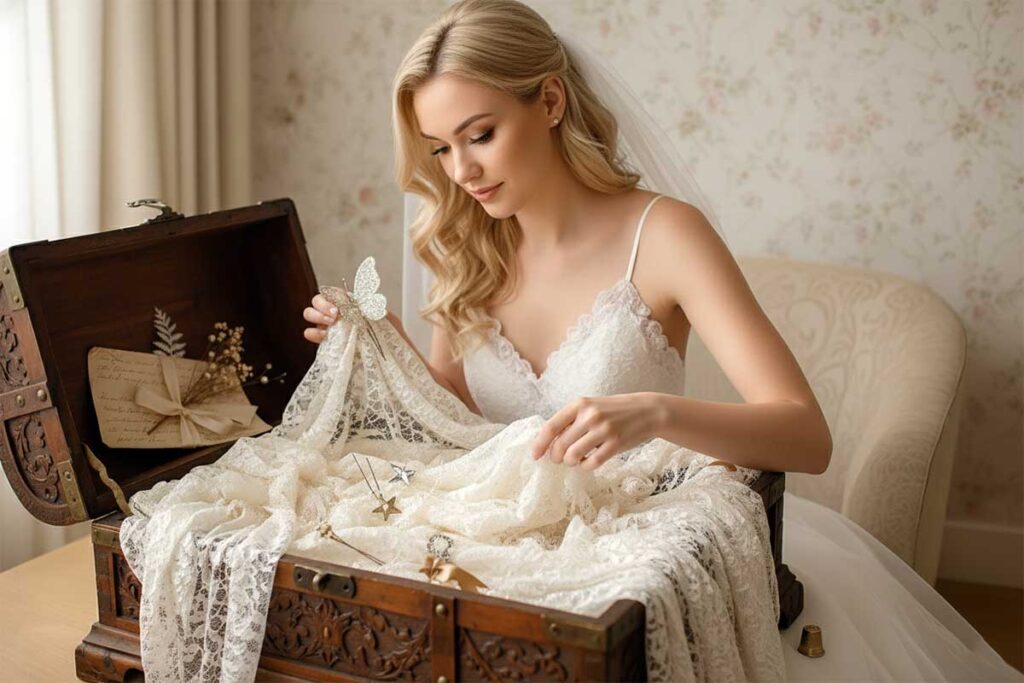You’ve invested time, emotion, and resources into the perfect gown, and you’ve ensured it’s been meticulously cleaned. But here’s a crucial truth: the biggest threat to your preserved gown often comes from the inside, the storage materials themselves. Moving beyond temporary storage solutions to adopt museum quality preservation standards is the only way to prevent irreversible chemical damage that can destroy your dress over time.
At Dress Preservation we don’t just clean gowns; we specialize in archival preservation. Here is why choosing an acid-free wedding gown box and archival-grade materials is the most vital step for your gown’s future.
Understanding the Enemy: Why Acid-Free Wedding Gown Box Materials are Vital
When discussing textile preservation, the term “acidic” refers to a low pH level in materials like paper and cardboard, often caused by the presence of lignin (the substance that makes wood products stiff). As these materials age, they slowly break down and release damaging acids.
What are acid-free materials and why are they vital for long-term storage?
Acid-free materials are defined as being pH neutral (a pH of 7 or higher) and are often chemically buffered with an alkaline compound. They are vital because they do not release the harmful chemicals that cause cellulosic fibers, like cotton, silk, rayon, and some synthetic blends, to degrade. Over time, acidic contact causes these fibers to yellow severely, become brittle, and eventually disintegrate. Archival materials halt this chemical deterioration, ensuring the fibers remain stable for generations.
The Pitfall of Common Packaging: Avoiding Disaster
If you’re considering DIY preservation using household items, you are unknowingly accelerating your gown’s ruin. Standard packaging is inherently designed for short-term use, not long term gown storage.
Is an ordinary cardboard box safe for gown storage?
Absolutely not. Standard cardboard and wrapping paper contain lignin and acid, which will leach directly into the delicate fabric. This causes direct contact yellowing, meaning wherever the material rests against the box’s edges or folds, a dark, permanent yellow stain will form. An ordinary cardboard box is essentially a ticking chemical time bomb that actively degrades the textile fibers. Furthermore, plastic bags made of PVC can trap moisture and off-gas harmful chemicals, leading to rapid fiber degradation and yellowing.
The Science of Protection: Achieving Museum Quality Preservation
True preservation relies on creating a stable, chemically inert micro-environment for the textile. This requires specialized materials working in concert.
The Role of Acid Free Tissue Paper in Archival Storage
The tissue paper we use is more than just cushioning; it is a critical scientific element of preservation. It must be pH neutral (acid-free) and is often buffered with an alkaline reserve to actively neutralize any environmental acids that might penetrate the box.
How do acid-free tissue papers protect the folds of the gown?
Acid free tissue paper serves three critical functions within the preservation box:
- Buffering Creases: It acts as a physical buffer, preventing fiber damage where the gown is tightly folded. Folds are weak points, and the tissue minimizes the stress placed on the fibers at those pressure points.
- Preventing Migration: It prevents static electricity buildup and ensures that two separate pieces of fabric (like a lace overlay touching a silk skirt, or a decorative element resting on a train) do not stick, transfer color, or leave residue.
- Moisture & Light Control: By filling air gaps, it helps stabilize the internal humidity and provides an additional barrier against light, which fades colors and accelerates decay.
The Archival Box: Structure and Safety
The acid-free wedding gown box itself is the final, crucial barrier. It is constructed from a high-grade, lignin-free board that guarantees chemical neutrality. The box is designed to be sturdy, protecting the gown from physical damage, but it is not completely airtight. A slight permeability is essential for allowing the garment to “breathe,” which prevents the harmful build-up of humidity and condensation inside. This specialized structure, combined with the inner acid-free tissue paper, guarantees the highest standard for storing wedding dress safely against environmental factors like dust, light, and humidity fluctuations.
Your Gown Deserves the Archival Standard
Preservation is a holistic system; the expert cleaning must be paired with the right archival materials to ensure long-term success. Don’t let your cherished garment become a victim of a ticking chemical time bomb. Trust the experts for genuine museum quality wedding dress preservation that guarantees your gown’s future.
Trust the experts at Dress Preservation for genuine museum quality preservation that guarantees your gown’s future. Learn more and schedule your preservation service at https://www.dresspreservation.com/.
Visual Data Reference
Material Type
Acidic Content
Long-Term Risk
Preservation Status
Standard Cardboard Box
High (Lignin)
Severe Yellowing, Brittleness
NOT RECOMMENDED
Blue/Colored Tissue Paper
High (Dyes/Acids)
Dye Migration, Staining
NOT RECOMMENDED
Plastic Garment Bag (PVC)
High (Off-gassing)
Fiber Degradation, Yellowing
NOT RECOMMENDED
Archival Acid-Free Materials
Zero/Buffered
Minimal (Ideal)
VITAL






